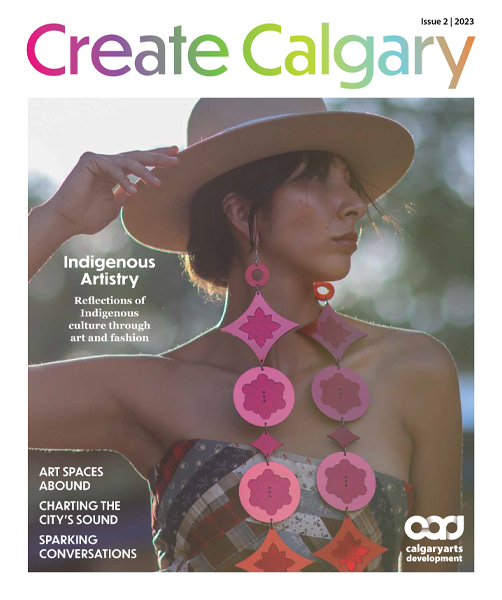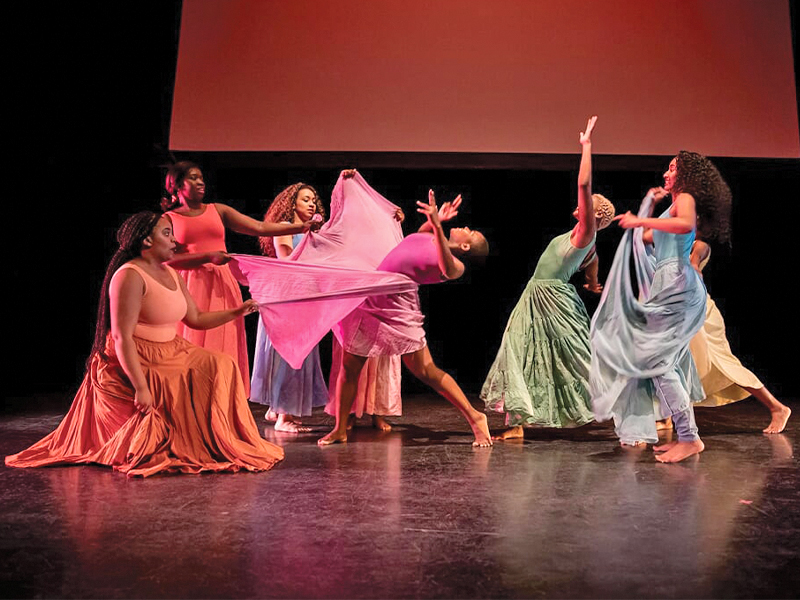How Art Can Change the Narrative
Calgary artists use their creative skills to connect with communities and propel social change
Art and the process of creating art can shift perspectives. It can tilt a complex issue in a way that clears a path toward common ground. Art gets us asking questions. It makes talking through different answers possible. Sometimes, it can create a seismic social change by bringing something into sharp focus or unlocking the empathy needed to listen and make meaningful progress. Often, its influence is subtle and layered. Art’s changemaking magic comes as we create it, the conversations it provokes and in the simple act of bearing witness. Art is about connecting with communities, and artists across Calgary are doing just that as they use their creativity to spur social change. Here’s a look at a few local artists and projects making a difference.
CONVERSATIONS WITH COMMUNITIES
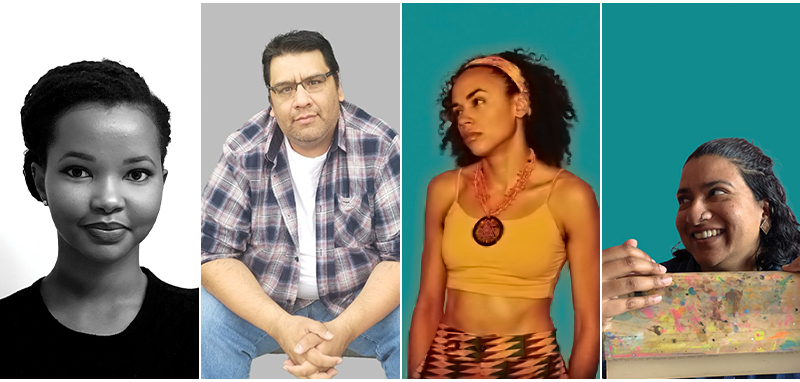
Left to right: Sally Njoroge, Tito Gomez, MelVee X and Skye Louis
Photos: Trico Changemakers Studio
Trico Changemakers Studio is a collaboration and learning space at Mount Royal University that brings people from on and off campus together to support and amplify changemaking. The studio believes everyone has the capacity to create change, but what makes it special is its attention to the power of artists.
“When we are talking about change within really, really big systems, whether that is around policy or changing someone’s behaviour, art and artists are in a unique position to do that,” says Sally Njoroge, program lead at Trico Changemakers Studio. Artists can break down complex concepts, she says. They can make them relatable and draw people in.
“We can talk about systems all day, but systems are created by people, and artists can communicate with people very well,” adds Njoroge.
Njoroge leads the Artist as Changemaker program (AAC). The residency program began in 2018 and is in its third cycle having now included 15 artists and 13 local organizations. In the program, artists choose community organizations they want to work with, and together, they hone in on a question and use art to explore the answers.
For example, filmmaker Tito Gomez worked with the Confederation Park 55+ Activity Centre. They wanted to know how they could bring more focus to the conversation around seniors and racism. Gomez spoke with four seniors from different Calgary communities to capture their heartbreaking and sometimes humorous stories on film.
For their AAC residency, MelVee X and Skye Louis worked with ActionDignity, an organization that brings together ethnocultural and racialized groups around social justice, human rights and equity. They wanted to illuminate the wholeness of human experience and create connections across differences.
MelVee X created workshops, a spring day camp on selfimage and spoken word kits, all the while embracing experimentation and flexibility to adapt and try new things as feedback came in. Louis led printmaking workshops during the COVID-19 pandemic. She explored the immigration journey of temporary foreign workers and created portraits to tell that story. She’s now creating a deck of cards that will be a toolkit for other artists to incorporate changemaking into their work.
The undercurrent of all the residencies and where the roots of social change are planted is in the exploration.
“It’s not only about the beautiful art that comes out of it,” says Njoroge. “It’s about the conversations that happen as the process takes place. People uncover things about themselves, their families and their communities. Those conversations take us into the past and present as well as what the future can look like. That’s where possibilities are unlocked and change is activated.
CREATING ART CAN CREATE CHANGE

Left to right: Kevin Jesuino, Kevin Allen and Everett Klippert (Far right)
Photos: Trico Changemakers Studio; Kevin Allen, Calgary Gay History Project
The process and not the product is also where Kevin Jesuino places his focus. Jesuino was an AAC resident and is currently part of its fellowship program working with the Alex Community Food Centre. His work with community-engaged arts often finds its spark in participation and improvisation.
“Art, for me, is the glue that holds culture together,” says Jesuino. “The very act of creating an invitation to participate can change someone.”
In 2018, he worked with the Gay-Straight Alliance at Western Canada High School on a theatre project that took a critical look at sex education. The show, What They Didn’t Teach Us, involved working with LGBTQ2S+ teens to learn what they wished was part of the curriculum, including a more robust and inclusive history of the rights and social issues related to sexuality as well as ideas around gender and consent. The show was billed as teenagers teaching adults about sex education.
While developing the performance, Jesuino brought in advocates from Calgary’s LGBTQ2S+ community, including Kevin Allen from Calgary Gay History Project. Allen taught the teens about Everett Klippert, who used to live in Calgary and was one of the last people in Canada to be imprisoned for homosexuality. Klippert was central to the discussion around decriminalizing homosexuality in Canada in the 1960s. His story created change among the students before they even stepped in front of an audience.
By tracing an important moment in the history of human rights to a real person from their city, the students felt a real connection to the cause. “The students got emotional,” recalls Jesuino. “They found Everett’s story incredibly inspirational. That story had been withheld from them in their social studies and sex education classes. There was a feeling of emotional catharsis. In that moment, everything became hyper-real.”
The process of creating art impacted the students. That might have been enough, but there was another ripple of impact. When the audience showed up for a performance during a particularly snowy Calgary blizzard, it was almost entirely made up of teachers. “It was people who wanted to hear these perspectives from these kids,” says Jesuino. “There’s changemaking in that.”
Along with Melanie Kloetzel, Jesuino is also a founder of TRAction. The collective of interdisciplinary artists engages communities in art-making to address climate change, mostly through performance and site-specific works.
“The anxiety of living through climate change has impacted different classes differently prior to now,” says Jesuino. “People of colour have had to face these realities long before we even realized climate anxiety was a real thing. This is especially true of Indigenous communities.”
TRAction shifted its focus to centring Indigenous voices. It’s now taking part in gatherings and discussions with Indigenous artists to help craft a toolkit based on the Indigenous perspective to climate. “We’re not leading it,” says Jesuino. “We’re holding space and that’s another approach to socially engaged art.”
THE IMPORTANCE OF HOLDING SPACE
Jared Tailfeathers agrees that holding space is important. The multidisciplinary artist often creates opportunities for art and community to interact and does so as artistic lead for Design Talks Institute (d.talks). d.talks hosts public discussions, screenings, events and exhibits around themes of architecture, art, culture and design to get diverse opinions about heritage, mobility, neighbourhoods and more, all to find common ground.
In 2023, d.talks partnered with Arkive, a decentralized museum created by a global community of artists and art leaders. It is building a collection of culturally significant art and artifacts that it temporarily places in hotels, universities and building lobbies around the world, including Calgary’s Central Library.
For five months this past year, Central Library visitors could view Electromagnetic Field — a nearly seven-by-five-foot work of art — that was made by dropping iron filings on a canvas and then moving the canvas above copper cables connected to a breaker. Puerto Rican artists Jennifer Allora and Guillermo Calzadilla created it in the aftermath of Hurricane Maria. What may appear like a relatively simple black and white work of art is really a conversation starter for global discussions around power grids, natural disasters, colonialism, capitalism, and the future of oil and gas.
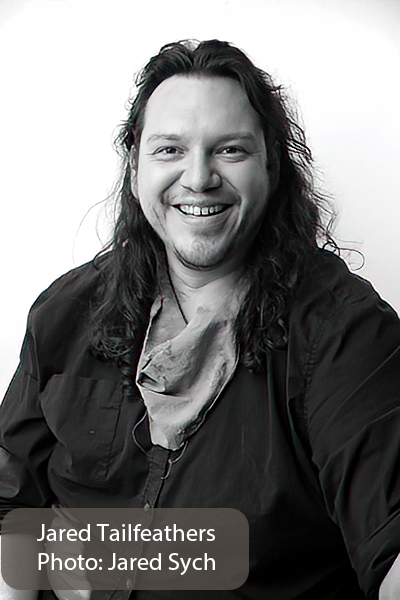
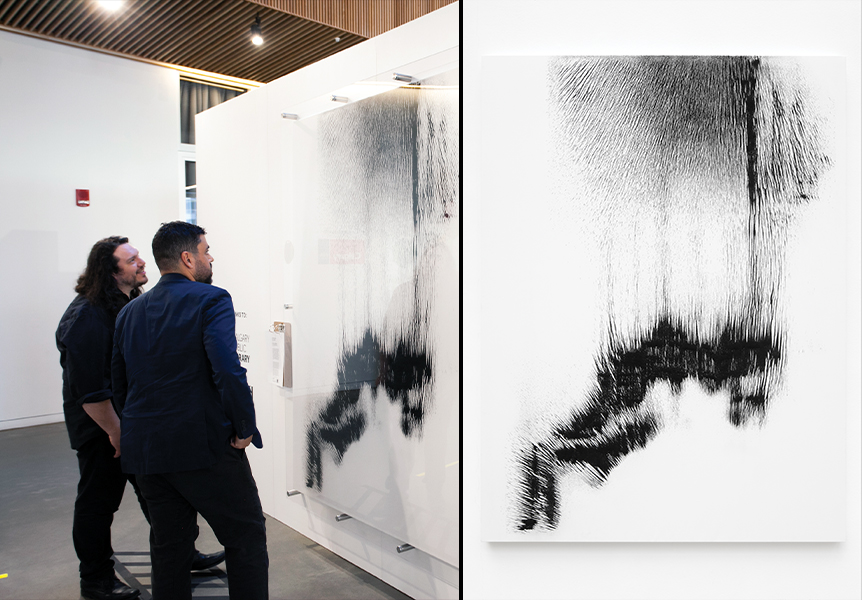
Left: Jared Tailfeathers at d.talks event Right: Electromagnetic Field
Photos: d.talks; ARKIVE
“Art is the driving force for social awareness,” says Tailfeathers. “We’re more on the same page than we may think we are. We can all live in the same creative space together and discuss important topics.”
TRANSFORMING THOUGHT THROUGH ART
Tailfeathers is also a member of Cultural Instigators, a grassroots group that was brought together by Calgary Arts Development in 2020 and includes Indigenous, Black and People of Culture/ Colour artists. Through their work, they focus on what an anti-racist Mohkinsstsis/Calgary would look like.
For Tailfeathers, that includes making sure people are educated about the history of this land. One of the projects he helped with is the IndigiTRAILS app created by the Urban Society for Aboriginal Youth. It includes interactive maps of locations significant to Indigenous history and culture, including Prince’s Island Park and Olympic Plaza. Tailfeathers worked on the Fort Calgary trail map that pairs art with trivia. By following the trail, the audience gains deeper knowledge of Treaty 7 from an Indigenous perspective while being physically present in that important location.
“It’s not just for artists or people with social justice mindframes,” says Tailfeathers. “It’s for everyone, including people who might not normally engage in these types of things.”
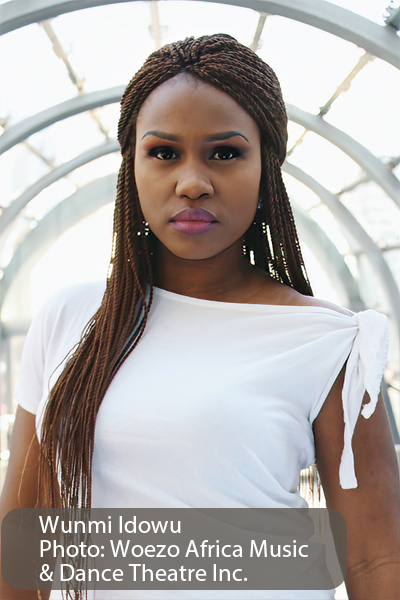
Fellow Cultural Instigator, Wunmi Idowu is the founder and director of Woezo Africa Music & Dance Theatre Inc. Each year, during Black History Month, Woezo creates a multimedia dance theatre production that celebrates the history and influence of African culture on modern dance called UNGANISHA: Explore. Connect. Dance. (Unganisha is a Swahili word for connection). The production blends storytelling, historic visuals and dance to demystify the origins of nine dance genres. It’s packed with details that have almost been wiped from the records, including the countries the enslaved people were stolen from and the history of how the dance genres were formed and preserved. UNGANISHA bridges that past with the present by highlighting dance styles like samba, tap, jazz and hip hop that emerged from that dark history.
“We use the production to transform the way people think,” says Idowu. “It reaches into the subconscious and draws on where their compassion lives. We can connect as human beings and not as black or white.”
In 2017, leading up to the first production of UNGANISHA (and before Black Lives Matter became a mainstream movement during the pandemic), people questioned why Idowu would open old wounds. “If we continue to work in ignorance, we will never see the truth,” she says.
After that first performance, an audience member asked to meet Idowu backstage. The woman had lived in the Caribbean almost her entire life and didn’t know the history of their dances and the impact of the Transatlantic slave trade on their culture. “She said thank you,” says Idowu. “That was huge.”
Such an affirmation validated Idowu’s goal for audience members to come away with a new understanding of history and with their biases checked. The goal is to challenge assumptions and reveal a common humanity.
No matter the medium, art does its best social change work when it reaches out into the community and creates opportunities for members to listen, learn and be heard. For Idowu, movement and storytelling plant seeds of social change. “Art has the power to change the narrative. It has the power to initiate important conversations and create sustainable solutions.”
This article was originally published in the 2023 edition of Create Calgary, an annual magazine launched by Calgary Arts Development in 2022 to celebrate the work of artists who call Mohkinsstsis/Calgary home.
You can pick up a free copy at public libraries, community recreation centres and other places where you find your favourite magazines. You can also read the digital version online here.
